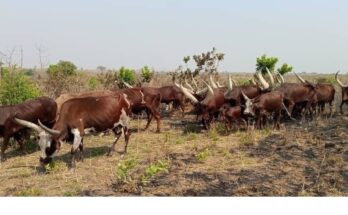Celsio Ocaya has not farmed any food crops at his home in Te-okot village, Got Apwoyo Sub County in Nwoya district for over four years.
Neither have other residents numbering over 200 living in the village that sits on the fringes of Murchison Falls National Park, one of the largest conservation areas in the country.
In recent years, the farmers living near the conservation area have been struggling to produce enough food to feed their families.
The locals told me when I visited the village recently that they know that if they planted crops, all their hard work would be trampled on by marauding elephants from Murchison Falls.
“You cannot harvest any crops here. We buy all our food even vegetables from elsewhere because elephants come and destroy anything we plant. If you sit out here in the evening starting from 6:00 pm, you will see elephants marauding in the compound. Even now you can see elephant’s foot marks here,” Ocaya said.
This leaves Ocaya and other locals with one option – to cut trees and burn charcoal to be able to buy food from markets at neighbouring Pakwach Town Council. They also use some of the money to hire land in neighbouring villages in Wii-Anaka to grow food crops.

But the trees are quickly dwindling turning, Te-okot into dry land. Ocaya argues that the proceeds from the charcoal business are helping him and other farmers to hire land for growing food crops.
“One big problem we face is the long distance to the farmlands; for example, going to Latoro needs transport means. It costs about Shs 6,000 to get there. The only thing we know to do to get money is to burn charcoal,” he said.
Aisha Chikawu, another affected farmer has hired a 2-acre piece of land in order to escape from the destructive elephants. Ms Chikawu said she paid UGX 100,000 to the land owner in Wii-Anaka village, about seven kilometers from Te-Okot where she grows staple food such as potatoes and maize.
She said if she had not hired the piece of land, members of her family were going to starve.
Chikawu said; “The land owners want cash, tractor owners also want cash just like the sellers of seeds. I have nothing else to do. If I die of hunger it’s ok, if the government can help us, let them do so.”
As elephants wander into the area after escaping from the conservation area, older persons here at Te-Okot Village have become more vulnerable.

Bicentina Akeba is a widow in her late 70s. Apart from the fact that age has taken a toll on her body, Akeba can neither walk for a long distance nor lift a hoe to cultivate. She is now being forced to depend on handouts since she can no longer grow her own food.
Akeba said that “Previously, we were growing and harvesting a lot from this same land but now we cannot farm because of the elephants. These days, life has become hard for us because I survive selling water to people. I sell each jerrycan at 500 shillings. When I fail to sell water, I am forced to depend on local residents for food.”
The matter of fact here in Te-Okot Village is that as the human population expands and natural habitat shrink, people and animals in this part of the park have increasingly come into conflict over living space and food.
This has resulted in the death of two people in recent years. The two victims were trampled to death by the wild elephants. Several attempts to deter the beasts with loud noises, whistles and the growing of chilli pepper have also not yielded fruits.
The initiative was funded by nongovernmental organizations (NGOs). Since it was counterproductive, some farmers have since abandoned growing chilli.
Celsio Ocaya, a local farmer who is also the Te-Okot Village Chairperson told me why they abandoned the fight against wildlife after just one season.
“We grew chilli on large pieces of land and had a good harvest but there were no buyers. We each planted an acre through support in terms of seeds from some organization. The organization kept monitoring our progress but did not come back to buy the chilli. We were forced to eat some of it while most of it got wasted,” Ocaya said.
He adds that the project is likely to have failed due to planned eviction by the government in order to set up an animal diagnostic centre.
“We only realized that MAAIF (Ministry of Agriculture, Animal Industry and Fisheries) was farming in the areas we used to farm. We no longer have rights over that land. They even demolished our pit latrines and barred us from passing on that land to reach nearby markets and health facilities in Pakwach or Latoro where we access food and health care.”
Tony Awany, the Member of Parliament (MP) for Nwoya County however argued that despite the fact that locals were consulted before the project was implemented in the area, there were several changes made. He noted this could have not gone well with the locals since they initially thought the project will go on according to plan.
“Right now we are seeing a land opening for the production of maize, soybeans and other crops which was not in the user clause of the land. Our appeal to MAAIF or NAGRIC or whoever is concerned is to completely stick to the user clause which is animal breeding,” Awany said
As part of a solution to the human-wildlife problem, in 2014, Uganda Wildlife Authority (UWA) funded the construction of a 36KM trench to protect the community against marauding elephants.
Recently, UWA also secured a 5.7 billion shillings grant from the World Bank to construct 101 km of electric fence around the national park.
Despite all the efforts being put by the agency to minimize human-wildlife conflict in Nwoya District, elephants have continued to wander into farmlands and devour crops such as maize, beans, rice and millet. It has also accelerated habitat loss and increased poaching in the area.
Hangi Bashir is the Communications Manager, Uganda Wildlife Authority (UWA). We asked him if funds were available to fence off the park in order to stop wild animals from straying into community land in Nwoya District.
He said, “We had halted it because we need to get a clearance of Environmental Impact Assessment. For now, that is what we have been working on. For every project, we have to do a detailed Environmental impact assessment. I cannot tell the actual kilometers we have worked on so far but I know this financial year we are targeting around 60 kilometers that side but I don’t think we will be able to achieve it.”
Bashir noted that trench digging depends on the availability of funds. Communities here at Te-Okot Village are dependent on land for subsistence.
This reporting was supported by the American Jewish Service through Northern Uganda Media Club-NUMEC.




